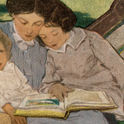British people of a certain age have a shared cultural memory of the Open University. A lecturer—usually a man—appears on television dressed in an alarming outfit, standing in front of a chalkboard or behind a demonstration table, talking earnestly to the camera about particle physics, or the Reformation, or the Upper Volta rivers. This programme might have been glimpsed whilst someone was up in the middle of the night feeding a baby, or stumbling in from the pub, or perhaps by a small child looking for entertainment early on a Saturday morning and finding only education.
For many people in Britain, those kipper-tied academics doing a chalk-and-talk lecture were their first, or only, exposure to higher education. The OU has changed dramatically since it was first established in 1969; the ‘university of the air’ has mostly moved from the television to the internet, and the kipper ties are mostly banished to the back of the wardrobe. But it remains a world-class educational institution; and now, its budget is under threat to the tune of £100million.
University staff at many pre-92 institutions have recently completed fourteen days of strike action, sparked by threatened changes which would see substantial cuts to pensions. In the context of the intransigence of UUK, the representative body for university leadership, as well as many individual VCs’ antagonistic attitudes, staff and students have used this space to think critically about wider concerns about higher education. Teach-outs, talks and debates have been organised attacking conceptual debates focussed on one, fundamental, question: what is the purpose of higher education in today’s society?
The strikes tap into a longer-term sense of anxiety and discontent among many people working in universities across Britain. The obsessive approach to metrics in teaching and learning—the REF, the TEF, and the proliferation of league tables—have created an environment where universities can feel more like factory assembly lines than sites of learning.
Against this context, the recent announcement giving detail to the cuts to the OU’s budget, first announced in June of last year, was greeted with dismay. Leaked internal documents revealed that the £100 million cuts announced last summer would lead to 41 undergraduate and postgraduate degree courses being axed; the total number of courses, qualifications and modules on offer to students cut by more than a third. Much of this budgetary reduction will be fulfilled through staff job losses, with a voluntary redundancy process opening in April.
Peter Horrocks, the Open University VC, claimed in February that his salary of £360,000 was justified because of the need for ‘appropriate leadership’ during this ‘restructuring’ process, which did not endear him to anxious, angry academics. This attitude, combined with his comments to students that OU staff had been allowed to “get away with not being teachers for decades,” has led to a vote of no confidence being tabled by university staff, and wider calls for Horrocks to resign.
The anger directed at these proposals, and Horrocks’ comments, don’t only reflect anxiety about the state of higher education. They reveal something important about the role of the Open University within Britain, and particularly British education.
"A vulgar intrusion"
The Open University was established in 1969 by Harold Wilson’s Labour government. In 1963, at the Labour party conference, Wilson had famously proclaimed that if the country was to prosper, a “new Britain” would need to be forged in the “white heat” of a “scientific revolution.” As part of this, he proposed a “university of the air” which could make “an immeasurable contribution to the cultural life of our country, to the enrichment of our standard of living.”The Open University was formed in the context of education reforms in the 1960s—in particular, the 1963 Robbins Report, which enshrined in British education policy the principle that university places “should be available to all who were qualified for them by ability and attainment.” But while the Robbins expansion of higher education was good news for new young middle-class students, it did little for the people who had already been forced out of education into work or who could not, for whatever reason, participate in a traditional university degree. The Open University was envisaged as a way to reach specifically those people—particularly women, whose post-school choices had been constrained by marriage and child-rearing.
The Open University may have been created under Harold Wilson, but it was brought into the world by the tenacity of Jennie Lee. She faced opposition from the Department of Education, other ministers, the Treasury, the broadcasting sector, and existing universities, who apparently thought it was a “vulgar intrusion.” But Lee was committed to the idea of a university education that could be experienced by the ordinary men and women in Britain.
The OU was revolutionary not only because it tried to change the assumption that adult education was somehow lesser, or that university education was only for the elite, but because it took some of the most cutting-edge educational technology and made it available to ordinary citizens. It wasn’t limited to vocational education (although this absolutely had a place within the OU; in fact, it is still the biggest provider of law degrees in the country). People could also study chemistry, art history, psychology.
"Nothing but the best is good enough"
By 4 August 1970, the closing date for prospective students to apply, the new university had received some 42,000 applications for 25,000 places. In January 1971 the first students started their courses. Over 30 per cent of them had less than two A levels or equivalent—the minimum qualification for entry to other British universities. 22 of the students were prisoners, starting a long relationship between the prison service and the OU. Quickly, academics like Stuart Hall, Asa Briggs and Doreen Massey would help to establish the OU as an important centre for research, as well as teaching.When she laid the stone for the first OU library in Milton Keynes in 1973, Lee proclaimed that they had created “a great independent university which does not insult any man or any women whatever their background by offering them the second best: nothing but the best is good enough.”
Today, the OU is the biggest academic institution in the UK, and one of the largest universities in the world; since it was begun, more than 2 million students have studied on its courses. Horrocks’ comments that his lecturers were not doing “real” teaching were seen as such a betrayal not only because the institution had spent so long patiently fighting against precisely this allegation, but because they revive the hierarchical, dismissive, divisive attitude that the university he leads was created to erase.
The OU matters, not just because of what it does (and it does a lot), but because of what it represents. It was created by Labour in the 1960s because they believed that a quality university education was a right of democratic citizenship. The Open Univerity was, and at its best still is, a way of challenging traditional assumptions about education: about who should be educated, and why, and how. Cutting it sends a message that these ideas are no longer important, at a time when they could not be more so. As university staff fight not only for their pensions, but for the values at the heart of higher education and research, we must not allow the OU and what it represents to be forgotten.












